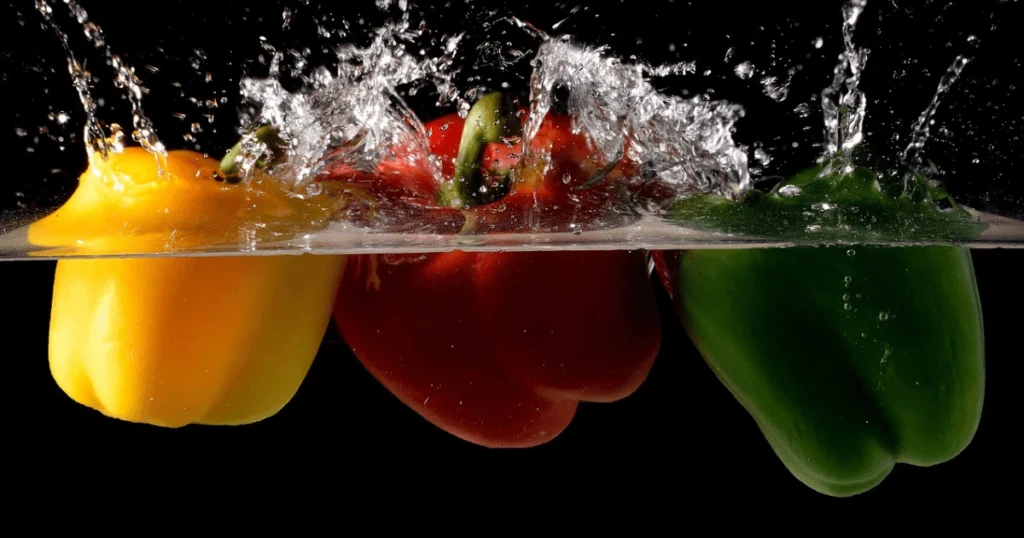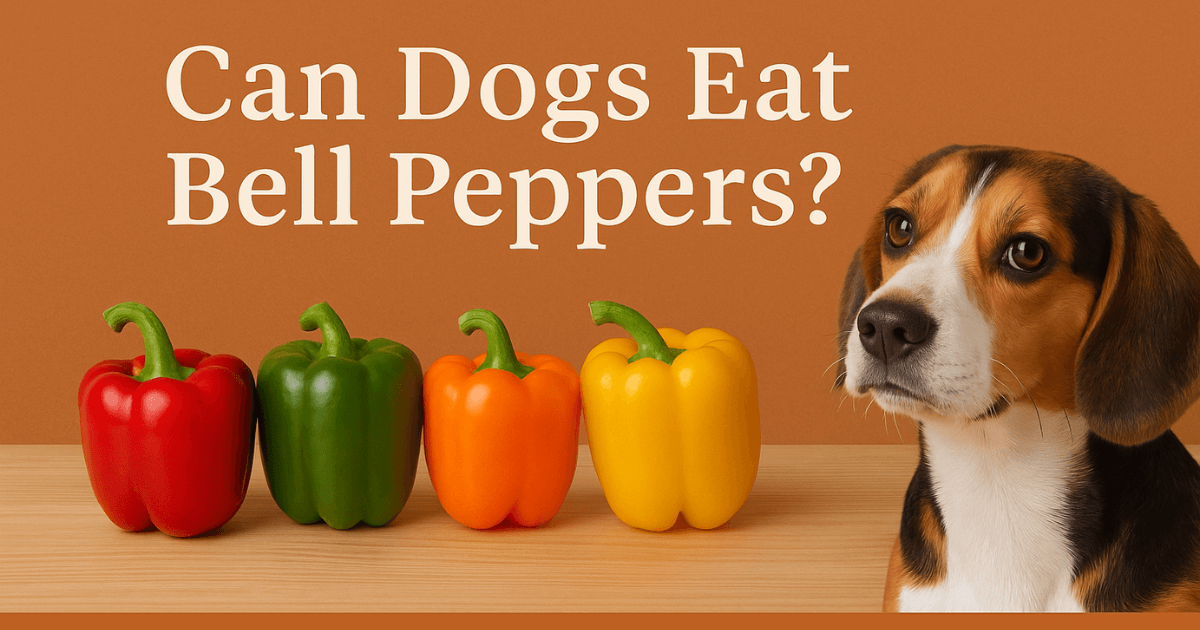Can Dogs Eat Bell Peppers? The Essential Guide to Safe & Healthy Snacking
Table of Contents
Can Dogs Eat Bell Peppers?
Bell peppers aren’t just for stir-fries and salads — they can also be a crunchy, colorful treat for your canine companion. But can dogs eat bell peppers safely? The short answer: Yes, as long as they’re served plain, properly prepared, and offered in moderation.
Packed with vitamins and antioxidants, bell peppers can deliver real nutritional benefits to your pup. In this post, we’ll break down what makes them safe, how to serve them, and when to say no. Whether your dog ate bell pepper by accident or you’re thinking of adding some to their bowl, we’ve got you covered.
Are Bell Peppers Safe for Dogs to Eat?
Bell peppers — whether red, green, yellow, or orange — are non-toxic and generally safe for dogs. In fact, many vets consider them a healthy treat when served correctly.
🫑 Can Dogs Have Bell Peppers of All Colors?
Yes! Dogs can eat any color bell pepper, though red bell peppers offer the most health benefits thanks to their higher levels of beta-carotene and vitamin C.
And can dogs eat green bell peppers? Absolutely — they’re just a little less sweet and nutrient-packed than their red counterparts.
Just remember these basics:
- Always serve them plain. No garlic, onion, spices, or seasoning.
- Remove stems and seeds. These parts can be tough to digest.
- Stick to small portions. Too much of any veggie can upset your dog’s stomach.
Health Benefits of Bell Peppers for Dogs
Yes — bell peppers aren’t just safe for dogs, they’re also full of important nutrients that can benefit your pup’s health in surprising ways. Whether you’re wondering “can dogs eat red bell peppers?” or “can dogs have bell peppers as a treat?”, the answer is a confident yes — when prepared properly and given in moderation.
These crunchy vegetables come in a rainbow of colors — red, green, yellow, and orange — and each variety packs a unique nutritional profile. But no matter the color, bell peppers are low in calories and high in vitamins, making them a vet-approved, guilt-free snack for most dogs.
A Natural Vitamin Boost
Bell peppers are a nutritional powerhouse, loaded with essential vitamins and antioxidants that support your dog’s whole-body wellness:
- Vitamin A – Supports eye health and immune function
- Vitamin C – Acts as a natural antioxidant and boosts immunity
- Vitamin E – Helps maintain a healthy skin barrier and shiny coat
- Vitamin B6 – Aids in metabolism, brain development, and red blood cell production
- Beta-carotene & Lutein – Protect cells from oxidative damage and promote healthy eyesight
These nutrients are especially abundant in red bell peppers, which contain the highest levels of vitamins and antioxidants compared to green or yellow varieties.
🟩 Can dogs eat green bell peppers? Yes — but red bell peppers offer the most health benefits, making them the top pick if you’re choosing just one.
💧 Hydration + Fiber = Happy Tummy
Bell peppers are over 90% water and contain a decent amount of dietary fiber. This makes them great for:
- Promoting regular digestion
- Supporting hydration, especially during hot weather
- Helping overweight dogs feel fuller without adding extra calories
Because they’re low in fat and calories, bell peppers are an ideal occasional treat, particularly for dogs that need to lose weight or avoid high-fat snacks.
Natural Anti-Inflammatory Properties
If your dog suffers from joint stiffness, arthritis, or age-related inflammation, red bell peppers may offer some gentle relief. Thanks to their rich antioxidant content, especially beta-carotene, they may help reduce oxidative stress and inflammation naturally.
This makes bell peppers a smart snack for senior dogs or breeds prone to joint issues — but always consult your vet before using any food as a health supplement.
🌟 Bonus Tip: Choose Red for Maximum Benefits
While all colors are safe in moderation, red bell peppers stand out as the most nutrient-dense option. They’re fully ripened and contain more beta-carotene and vitamin C than green or yellow ones. So, when in doubt — go red.
How to Safely Serve Bell Peppers to Dogs

While bell peppers are safe, how you serve them makes all the difference. Let’s break it down so your pup gets the benefits without any bellyaches.
✅ Color Matters, But All Are Safe
- Can dogs eat red bell peppers? Yes — and they’re the most nutritious.
- Can dogs eat green bell peppers? Also yes, though they’re slightly less sweet and nutrient-rich.
- Orange and yellow peppers are fine, too.
Stick with small servings:
- Small dogs: 1–3 small slices
- Large dogs: Up to half a bell pepper (cut up)
Treats should make up no more than 10% of daily calories.
Raw vs. Cooked Bell Peppers for Dogs
- Can dogs eat bell peppers raw? Yes — raw bell peppers are crunchy and hydrating, but some dogs may find them hard to chew or digest.
- Lightly steamed or pureed bell pepper is easier on the stomach and still retains most nutrients.
Avoid frying or roasting with oil — plain is best.
⚠️ Avoid These Prep Mistakes
- ❌ Don’t add salt, garlic, onions, butter, or spices.
- ❌ Don’t give them the stems or seeds — they can be tough to digest and are mildly toxic.
- ❌ Never serve spicy peppers (like jalapeños or chili peppers) — they’re not the same as bell peppers and can cause stomach upset.
Pro Tip: Start slow. Offer a small piece and watch for any signs of gas, bloating, or loose stool.
Risks and Precautions When Feeding Bell Peppers to Dogs

While dogs can have bell peppers, they’re not entirely risk-free. Here’s what to watch out for before you let your pup chomp down.
⚠️ Digestive Upset
Giving too much bell pepper — or introducing it too quickly — can lead to:
- Vomiting
- Diarrhea
- Gas or bloating
Start with a small piece, and monitor how your dog reacts. If your dog ate bell pepper and seems off, skip the second helping and consult your vet if symptoms persist.
Nightshade Family = Solanine Concerns
Bell peppers are part of the nightshade family, which includes tomatoes and potatoes. While ripe bell peppers are low in solanine, the stems, leaves, and unripe green parts do contain trace amounts. These could be toxic in large amounts — especially for small or sensitive dogs.
🚫 Remove all green stems and leaves. Never give your dog an unripe or bitter pepper.
Never Feed Spicy Peppers
This is a common mistake: Spicy ≠ Bell.
- Jalapeños
- Chili peppers
- Banana peppers
- Anything with capsaicin
These are dangerous and will likely cause GI irritation, drooling, and discomfort.
⚖️ Overfeeding = Trouble
Even healthy veggies can cause nutritional imbalances or interfere with your dog’s regular food if overfed.
- Use bell peppers as an occasional treat, not a diet staple.
- Stick to the 10% rule for all snacks and treats.
Quick Reference Table: Can Dogs Eat Bell Peppers?
| Bell Pepper Type | Safe for Dogs? | Notes |
|---|---|---|
| Red, Yellow, Orange, Green (Raw) | ✅ Yes (in moderation) | Most nutritious when plain and seedless — red has the most antioxidants. |
| Red, Yellow, Orange, Green (Steamed) | ✅ Yes | Easier to digest for sensitive pups. |
| Bell peppers with seasoning/oil | ❌ No | Onions, garlic, and fats are toxic to dogs. |
| Spicy peppers (Jalapeño, Chili) | ❌ No | Contain capsaicin — can cause stomach pain, vomiting, etc. |
| Pepper stems, seeds, or leaves | 🚫 No | Can contain solanine; remove before serving. |
Frequently Asked Questions
Can dogs eat red bell peppers every day?
No. Even though red bell peppers are the most nutritious, they should be served as an occasional treat — not a daily habit. Once or twice a week is ideal.
Can puppies eat bell peppers?
Yes, but only in very small amounts and always soft or pureed. Puppies have sensitive digestive systems, so introduce slowly and watch for any signs of tummy trouble.
Can dogs eat bell peppers raw?
Yes — raw bell peppers are safe. But if your dog struggles to chew the skin, try steaming or blending for easier digestion.
Which color bell pepper is best for dogs?
Red bell peppers have the highest levels of vitamins and antioxidants. They’re sweeter, softer, and generally more palatable than green ones.
What if my dog ate a lot of bell pepper?
If your dog ate bell pepper in large quantities, watch for vomiting, diarrhea, or gas. Contact your vet if symptoms don’t resolve in 24 hours.
Conclusion
So, can dogs eat bell peppers? Absolutely — as long as they’re served plain, properly prepared, and offered in moderation. Whether red, green, yellow, or orange, bell peppers bring a burst of nutrition to your dog’s snack game.
Just remember:
- Stick with raw or lightly steamed
- Always remove stems and seeds
- Avoid oils, spices, and anything spicy
- Watch your dog’s reaction to new foods
Bell peppers aren’t just safe — they’re a fun, crunchy way to boost your pup’s health. As always, talk to your vet if you’re unsure how new treats fit into your dog’s unique diet.
🐶 Have you tried giving bell peppers to your dog? Drop your experience in the comments or check out more safe fruits and veggies in our Human Food for Dogs section!

